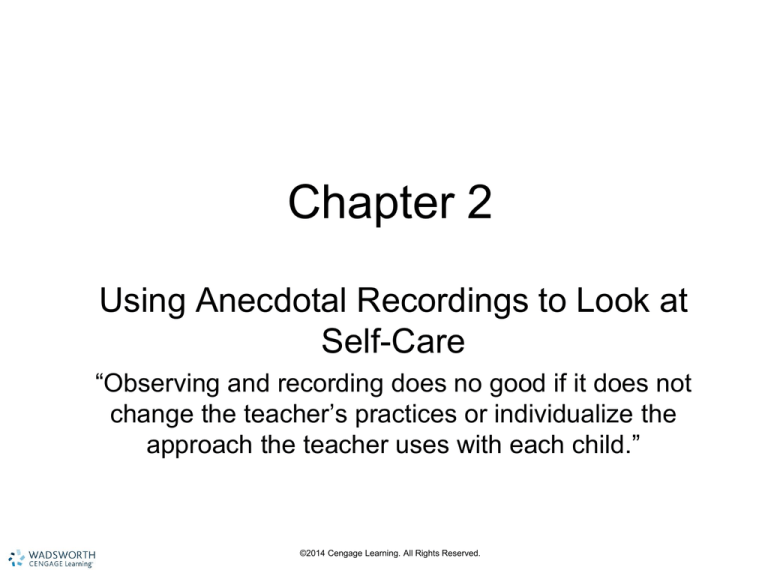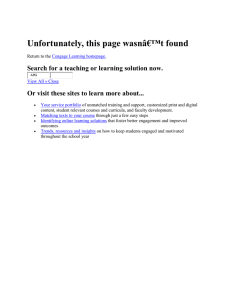
Chapter 2
Using Anecdotal Recordings to Look at
Self-Care
“Observing and recording does no good if it does not
change the teacher’s practices or individualize the
approach the teacher uses with each child.”
©2014 Cengage Learning. All Rights Reserved.
ANECDOTAL RECORDING
• Detailed, factual account of what the
recorder sees and hears; best if it’s written
immediately after the incident
• Narrative: when, where, who, and what
happened and the result
• Like a very short story
• Includes direct quotes
• Inferences or conclusions are kept
separate
©2014 Cengage Learning. All Rights Reserved.
Anecdotal Record
©2014 Cengage Learning. All Rights Reserved.
Uses of the Anecdotal Record
Advantages
• Preserves all the
important details
• Others can read it to
make their own
interpretations
• Needs no special forms
• Gives reader a sense of
being there
• Useful for all areas of
development
• Child abuse reporting
Disadvantages
• Difficult to write without
inferences slipping in
• Takes time and attention
away from children to write
• Selection of incident that
may be a positive or
negative impression
• Limited to one or two
children at a time
©2014 Cengage Learning. All Rights Reserved.
The Language of Observation
• Descriptive:
– Verbs
– Adverbs
– Adjectives
– Tense
– Sequence
• Learning stories
• Opportunities: interests, involvement,
persistence, expressions
©2014 Cengage Learning. All Rights Reserved.
What to Do with It
• File in child’s portfolio/folder
• Use to individualize the curriculum for
that child
• Share with other teachers and family
for insight
• Confer with helping professionals
• Talk with child
• Evidence to Child Protective Services
©2014 Cengage Learning. All Rights Reserved.
LOOKING AT SELF-CARE
SKILLS
• Dependent on:
– Physical, emotional, cognitive, social
development
• Influenced by:
– Heredity, family, peers, experiences, culture
• Autonomy
– Growing independence
©2014 Cengage Learning. All Rights Reserved.
TOPICS IN OBSERVATION
Using All Our Senses
What can you tell about a child from each of
your senses?
•
•
•
•
•
•
Seeing – Appearance, activities, safety
Hearing – Language, emotions, health
Touching – Muscle tone, illness, stress
Smelling – Hygiene, illness, home odors
Tasting – Probably not
The “Sixth Sense” – Emotional radar
©2014 Cengage Learning. All Rights Reserved.
Self-Care Skills
•
•
•
•
•
•
Eating
Toileting
Dressing
Personal hygiene
Sleeping
Behavior in the classroom
©2014 Cengage Learning. All Rights Reserved.
INFANTS AND TODDLERS IN
ROUTINES
• Necessary for quality and informative care
• Opportunities for observing and recording
– Feeding and eating
– Diapering and toileting
– Napping
©2014 Cengage Learning. All Rights Reserved.
HELPING ALL CHILDREN WITH
SELF-CARE SKILLS
•
•
•
•
•
Cultural Approaches to Self-Care
Children with Special Needs
Individualized Family Service Plan (IFSP)
Individualized Education Plan (IEP)
Helping Professionals
©2014 Cengage Learning. All Rights Reserved.
Standard Related to Self-Help
Skills
NAEYC Early Childhood Program Standards
and Accreditation Criteria
4.B.02 Assessments Obtain information on
all areas of children’s development and
learning, including cognitive skills,
language, social-emotional development,
approaches to learning, health, and
physical development (including self-help
skills).
©2014 Cengage Learning. All Rights Reserved.





